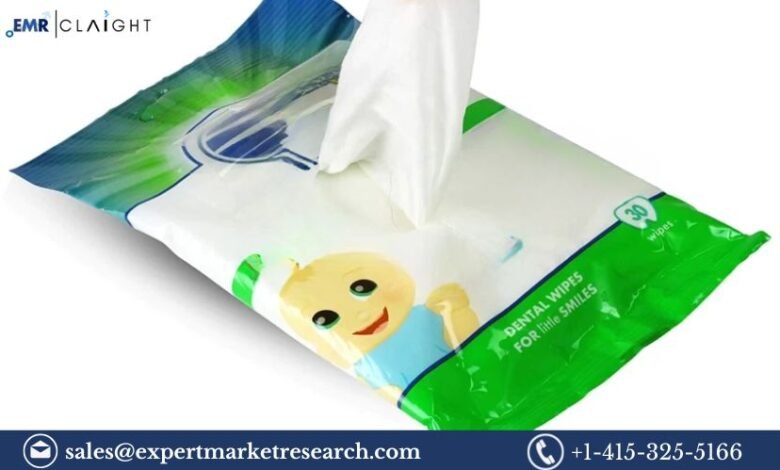Dental Wipes Manufacturing Plant Project Report 2024: Plant Setup and Insights
Dental Wipes Manufacturing Plant Project Report 2024

Introduction
Dental wipes are specialized hygiene products designed to help maintain oral cleanliness and prevent the buildup of plaque, bacteria, and germs. They are particularly useful for people who are unable to brush their teeth regularly, such as the elderly, bedridden patients, and young children. Dental wipes offer a convenient, portable, and effective way to freshen the mouth and ensure oral hygiene between brushing. The increasing awareness of oral health and convenience-driven solutions has led to the growing demand for dental wipes in both residential and healthcare sectors. Setting up a Dental Wipes Manufacturing Plant requires careful planning, technical expertise, and an understanding of market dynamics. A Dental Wipes Manufacturing Plant Project Report outlines the key steps, from market analysis and production to financial planning and safety standards, for successfully establishing a facility dedicated to producing dental wipes.
1. Market Analysis and Demand Assessment
Before starting any manufacturing plant, market research is essential to evaluate the demand and understand industry trends. The market for dental wipes is driven by the increasing awareness of oral health, the convenience of personal care products, and the aging population.
Target Market
- Consumers: Dental wipes are primarily used by people who seek a quick and effective solution for oral hygiene on the go. Parents of young children, elderly individuals, and those with medical conditions that limit their ability to brush are the primary target audience.
- Healthcare Sector: Dental wipes are widely used in hospitals, nursing homes, and dental clinics, particularly for patients who have difficulty brushing their teeth regularly.
- Travel and Outdoor Use: With the growing trend of outdoor activities and travel, there is an increased demand for portable oral hygiene products like dental wipes.
Trends Driving Demand
- Convenience: With fast-paced lifestyles, people are increasingly looking for easy-to-use products that don’t require water or a toothbrush, which is where dental wipes come in.
- Health Consciousness: As consumers become more aware of oral health’s role in overall well-being, there is a rise in the use of oral hygiene products like dental wipes to maintain mouth freshness and cleanliness.
- Product Innovations: The market is also witnessing innovations such as biodegradable dental wipes, wipes with added dental care ingredients like fluoride, and wipes designed for specific dental concerns (e.g., sensitive teeth or bad breath).
Regulatory Environment
Given that dental wipes are a healthcare product, they must comply with strict regulations concerning safety, packaging, and labeling. Understanding the regulatory requirements in the target market is critical, as non-compliance could lead to legal issues and hinder market entry.
Get a Free Sample Report with Table of Contents@
2. Planning the Manufacturing Facility
The manufacturing plant should be carefully planned to ensure smooth operations, regulatory compliance, and high-quality output. This includes determining the right location, plant size, and layout to optimize production and minimize costs.
Site Selection
When choosing a location for the manufacturing facility, several factors need to be considered:
- Proximity to Raw Materials: Sourcing materials such as non-woven fabric, antiseptic agents, and preservatives should be a priority. A location close to suppliers can reduce transportation costs.
- Labor Availability: A skilled workforce, including chemical engineers, machine operators, and quality control specialists, is essential for maintaining product quality and operational efficiency.
- Infrastructure and Transportation: Easy access to roads, railways, and airports for distributing finished goods is crucial for meeting demand in local and international markets.
Plant Size and Layout
The size of the plant depends on the scale of production, but a typical dental wipes manufacturing plant can occupy between 5,000 and 20,000 square feet. The plant should be divided into specific areas such as:
- Raw Material Storage: A clean and organized space to store raw materials such as fabric, chemicals, and packaging materials.
- Manufacturing Area: The core production area where the wiping material is processed, impregnated with ingredients, and cut into sheets.
- Quality Control: A dedicated area for checking the quality of the dental wipes, including testing for antimicrobial effectiveness, wipe texture, and moisture content.
- Packaging: The final step where the wipes are packed in sterilized and safe packaging, ready for shipment.
- Waste Management: A separate space for handling waste products, including used chemicals and packaging materials, following environmental regulations.
3. Manufacturing Process of Dental Wipes
The process of manufacturing dental wipes involves multiple steps, from fabric preparation to impregnation and packaging. The following is an overview of the key stages involved:
Raw Material Selection
The primary raw materials for dental wipes include:
- Non-Woven Fabric: Dental wipes are usually made from soft, non-woven fabric that is gentle on the mouth and gums. Materials like polyester, rayon, or a blend of both are commonly used.
- Antiseptic Solutions: Ingredients like chlorhexidine, cetylpyridinium chloride, or essential oils (like peppermint or tea tree oil) are added for their antimicrobial properties.
- Preservatives and Additives: Preservatives are used to prevent the growth of bacteria and extend the shelf life of the wipes. Additionally, moisturizing agents like aloe vera or glycerin are added to keep the wipes soft and prevent irritation.
Fabric Impregnation
Once the non-woven fabric is selected and cut to the desired size, it is passed through a solution tank where the active ingredients (antiseptic, preservatives, flavoring agents) are evenly distributed onto the fabric. The fabric is thoroughly soaked to ensure that the ingredients are uniformly applied. This process requires precision to ensure the right amount of solution is absorbed by the fabric.
Cutting and Shaping
After impregnation, the fabric is cut into individual wipes, typically in square or rectangular shapes. Automated machines are used for this purpose to ensure uniformity in size and shape.
Packaging
The final wipes are packed in sealed, sterile packaging, often in individually wrapped sachets or in a convenient dispenser pack. The packaging ensures that the wipes remain moist and free from contamination. The packaging must be air-tight, easy to open, and portable for consumer convenience.
Quality Control
Throughout the manufacturing process, stringent quality control measures are implemented. This includes checking the consistency of fabric texture, ensuring the proper amount of solution is applied to each wipe, and testing for microbial effectiveness. Finished wipes are also subjected to packaging inspections to ensure there are no defects or leaks.
4. Machinery and Equipment
The machinery used in dental wipes manufacturing includes:
- Fabric Cutting Machines: These machines precisely cut the non-woven fabric into the required size.
- Impregnation Machines: Equipment used to soak the fabric with the antimicrobial solution.
- Wipe Folding and Packaging Machines: These machines fold the wipes into the appropriate form and package them in sterilized containers.
- Quality Control Equipment: Devices for checking the effectiveness of antiseptic agents and ensuring the wipes are up to standard.
- Sterilization Units: Equipment that ensures the wipes are sterile before packaging to prevent any microbial contamination.
5. Workforce and Human Resources
A dental wipes manufacturing plant requires skilled labor for various roles, including:
- Production Workers: Operate the machinery and oversee the manufacturing process.
- Chemical Engineers: Oversee the formulation of the antiseptic solutions and ensure that they are safe and effective.
- Quality Control Specialists: Monitor the quality of raw materials and finished products, ensuring that the wipes meet industry standards.
- Packaging Staff: Ensure the packaging is done correctly and that the product is sealed and stored safely.
Training and regular safety drills are necessary to maintain high standards in product quality and workplace safety.
6. Financial Considerations
Setting up a dental wipes manufacturing plant requires significant investment. Key financial considerations include:
- Capital Investment: The initial investment will cover land, construction, machinery, raw materials, and labor costs.
- Operating Costs: Recurring costs include raw materials, labor, utilities, maintenance, and regulatory compliance.
- Revenue Streams: Revenue is generated from selling dental wipes to retailers, healthcare institutions, and directly to consumers through e-commerce platforms.
A detailed financial analysis, including projected sales, profit margins, and break-even analysis, should be done to assess the plant’s profitability.
7. Marketing and Distribution
To succeed in the competitive dental wipes market, effective marketing and distribution strategies are crucial. Potential strategies include:
- Retail Partnerships: Distributing the product through supermarkets, pharmacies, and online retailers.
- Branding and Packaging: Attractive and informative packaging can help differentiate the product in a crowded market.
- Health and Wellness Marketing: Targeting healthcare institutions, nursing homes, and dental clinics can help expand the customer base.
- Online Sales: Leveraging e-commerce platforms and social media to reach consumers directly.
FAQ
1. What are the key ingredients in dental wipes?
The key ingredients are non-woven fabric, antiseptic agents (like chlorhexidine), preservatives, and sometimes flavoring or moisturizing agents.
2. What machines are used in dental wipes production?
Essential machines include fabric cutting machines, impregnation machines, folding and packaging machines, and quality control testing equipment.
3. How is the quality of dental wipes ensured?
Quality control involves testing for correct fabric texture, even impregnation of antiseptic solutions, microbial effectiveness, and proper packaging integrity.
4. Can dental wipes replace brushing?
Dental wipes are a convenient alternative for maintaining oral hygiene when brushing is not possible, but they should not replace regular brushing and flossing.
Related Reports
https://www.expertmarketresearch.com.au/reports/australia-online-gambling-market
https://www.expertmarketresearch.com.au/reports/australia-online-grocery-delivery-market
https://www.expertmarketresearch.com.au/reports/australia-paints-market
Media Contact:
Company Name: Claight Corporation
Contact Person: Lewis Fernandas, Corporate Sales Specialist — U.S.A.
Email: sales@expertmarketresearch.com
Toll Free Number: +1–415–325–5166 | +44–702–402–5790
Address: 30 North Gould Street, Sheridan, WY 82801, USA
Website: www.expertmarketresearch.com
Aus Site: https://www.expertmarketresearch.com.au


